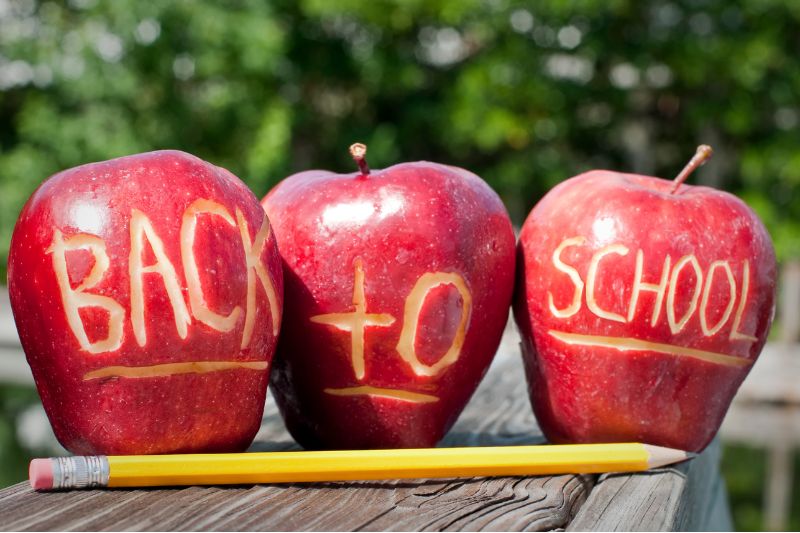Dealing with ‘Back to School’ Anxiety: 5 Tips to Assist your Child or Teen with ADHD Make a Smooth Transition
 Back to school is a time which usually comes with a mix of excitement and worry. For kids and teens with ADHD, there tends to be a little more anxiety around shifting to a school routine and schedule, navigating unfamiliar social dynamics, and a whole lot of “what if…” questions. Plus, COVID is still very much in the picture, requiring us to consider health and safety measures for the school year once again. Taken all together, this can create worries and stress not only for the kids but for the parents as well. So how can parents reduce back to school anxiety for themselves and their kids? Here are 5 tips for reducing back to school anxiety and making the re-entry as smooth as possible for ADHD kids and teens and their parents.
Back to school is a time which usually comes with a mix of excitement and worry. For kids and teens with ADHD, there tends to be a little more anxiety around shifting to a school routine and schedule, navigating unfamiliar social dynamics, and a whole lot of “what if…” questions. Plus, COVID is still very much in the picture, requiring us to consider health and safety measures for the school year once again. Taken all together, this can create worries and stress not only for the kids but for the parents as well. So how can parents reduce back to school anxiety for themselves and their kids? Here are 5 tips for reducing back to school anxiety and making the re-entry as smooth as possible for ADHD kids and teens and their parents.
5 Tips to Smoothly Transition Kids Back to School
1. Manage your own concerns first
 Kids have an incredible radar. They easily pick up when their parents are stressed or anxious and it increases their own distress, conscious or unconscious. The first step in decreasing the anxiety your child or teen is feeling is to lower your own. Take a few minutes and discuss your concerns with your partner, a friend, extended family member or counselor. Write these down and then strategize responses or to-do action items to each one by creating an “Anxiety Decelerator Plan.” This ADP will help you feel like you have some control. For instance, if your child needs more support than they received in the spring, one of your action items should be to contact the school adjustment or guidance counselor and set up a meeting.
Kids have an incredible radar. They easily pick up when their parents are stressed or anxious and it increases their own distress, conscious or unconscious. The first step in decreasing the anxiety your child or teen is feeling is to lower your own. Take a few minutes and discuss your concerns with your partner, a friend, extended family member or counselor. Write these down and then strategize responses or to-do action items to each one by creating an “Anxiety Decelerator Plan.” This ADP will help you feel like you have some control. For instance, if your child needs more support than they received in the spring, one of your action items should be to contact the school adjustment or guidance counselor and set up a meeting.
2. Identify their worries
 In order to reduce the frequency or intensity of kids anxiety we must first know what’s causing it. Being worried, thinking and environmental triggers can all set children and teens off leading them down the rabbit hole. But, we want to stop this tumble. During your weekly or twice a week check-in meetings (which are a must), explore with your child what feels uncomfortable or uncertain to them about returning to school or their day-to-day experience. Write these down together and pick one fear to address first and when its volume is lower, then pick another and so on. Working on one issue at a time is not only more manageable, but will allow you to make progress faster. Remember, people can really only change one thing at a time.
In order to reduce the frequency or intensity of kids anxiety we must first know what’s causing it. Being worried, thinking and environmental triggers can all set children and teens off leading them down the rabbit hole. But, we want to stop this tumble. During your weekly or twice a week check-in meetings (which are a must), explore with your child what feels uncomfortable or uncertain to them about returning to school or their day-to-day experience. Write these down together and pick one fear to address first and when its volume is lower, then pick another and so on. Working on one issue at a time is not only more manageable, but will allow you to make progress faster. Remember, people can really only change one thing at a time.
3. Consider prior successes
 When kids are anxious, they experience amnesia about times in the past when they overcame obstacles. Talk to your child about a situation or two from the previous school year when there was a challenge that they dealt with successfully. What happened? What did they rely on inside of themselves to do this? Did anyone assist them? and write down their responses. Each child’s response is a critical piece of your youngster’s resilience toolkit that they will need for bouncing back from anxiety. Then link some of these tools to the worry that you both have agreed to work on, and cue them to use this tool and check in about how it’s going at your family check-ins. Brainstorming about what you can do to assist them works for both of you, especially in reducing anxiety for your ADHD tweens and teens.
When kids are anxious, they experience amnesia about times in the past when they overcame obstacles. Talk to your child about a situation or two from the previous school year when there was a challenge that they dealt with successfully. What happened? What did they rely on inside of themselves to do this? Did anyone assist them? and write down their responses. Each child’s response is a critical piece of your youngster’s resilience toolkit that they will need for bouncing back from anxiety. Then link some of these tools to the worry that you both have agreed to work on, and cue them to use this tool and check in about how it’s going at your family check-ins. Brainstorming about what you can do to assist them works for both of you, especially in reducing anxiety for your ADHD tweens and teens.
4. Avoid reassurance and rely on acknowledgment
 Anxiety loves reassurance. But while reassurance brings about short-term relief, it increases long-term anxiety because it doesn’t teach kids the skills they need to do this for themselves. Avoid saying things like, “Don’t worry, it’s all going to work out!” This doesn’t address your child’s specific worry, and they won’t just take your word for it that everything will turn out ok. What parents need to do is acknowledge the fear and validate their concerns. Say something like “Yes, of course you are worried about getting more homework this year. It’s an understandable concern. How did we handle the workload last year? How can we apply those tactics this school year?”
Anxiety loves reassurance. But while reassurance brings about short-term relief, it increases long-term anxiety because it doesn’t teach kids the skills they need to do this for themselves. Avoid saying things like, “Don’t worry, it’s all going to work out!” This doesn’t address your child’s specific worry, and they won’t just take your word for it that everything will turn out ok. What parents need to do is acknowledge the fear and validate their concerns. Say something like “Yes, of course you are worried about getting more homework this year. It’s an understandable concern. How did we handle the workload last year? How can we apply those tactics this school year?”
5. Create a new normal for back to school
Things have fundamentally changed since COVID began and, while we desire our old normal, it’s not here. We continue to adjust and adapt to new rhythms. In spite of that, do your best to focus on the positives and what you and your child have to look forward to. For additional support, identify available resources to lean on such as educational tutors, community programs, and social connections. And be sure to make time with friends and family, exercise, and practice stress-management as a part of your family’s new normal. This shift in your focus will aid your kids with ADHD who naturally wrestle with flexibility to pivot more successfully towards reducing anxiety for you, your child and your family. 
Sign up for my newsletter to receive 10% off of your first purchase in my store!

Follow me on social media: YouTube, Facebook, Twitter, Instagram.
Coaching/Counseling | Presentation/Workshops | Podcast Interviews | Subscribe to our newsletter
